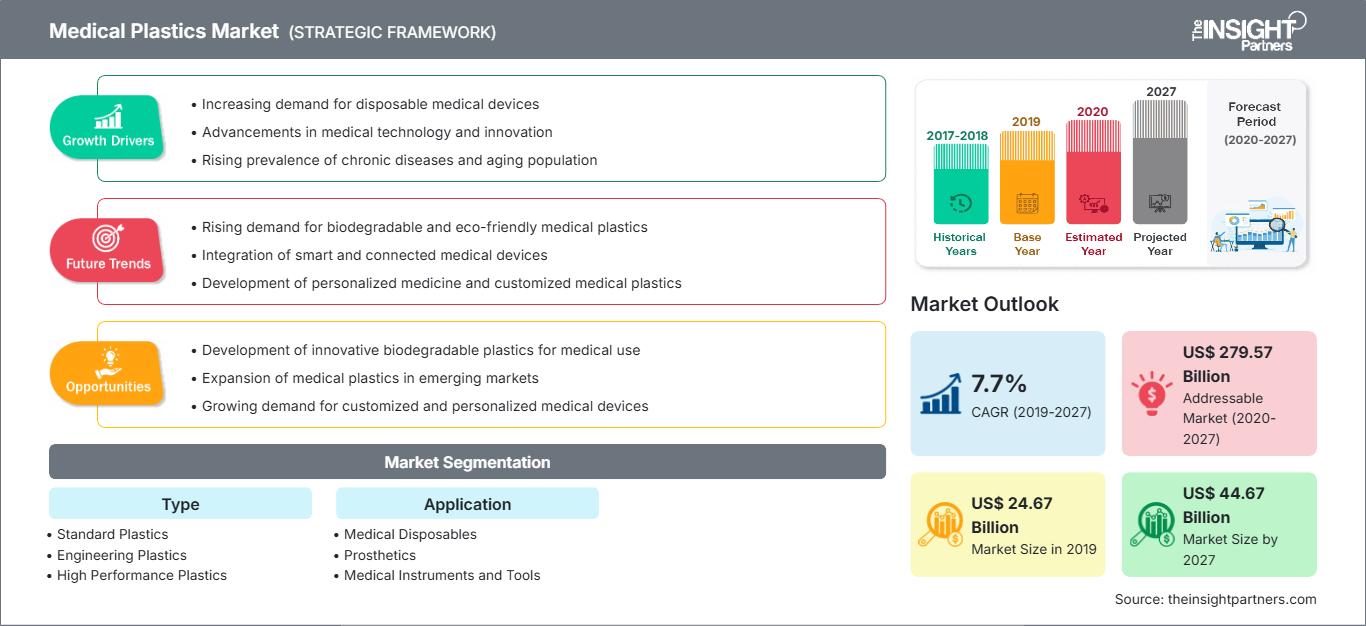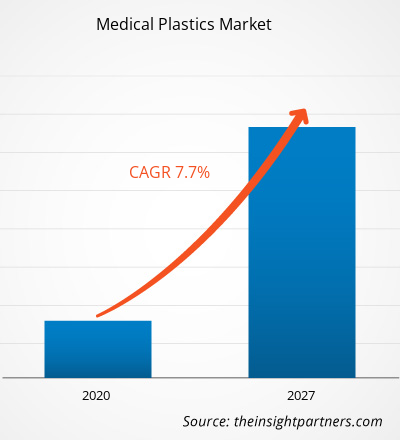Il mercato delle materie plastiche medicali è stato valutato a 24.671,82 milioni di dollari nel 2019 e si prevede che raggiungerà i 44.669,63 milioni di dollari entro il 2027; si prevede una crescita a un CAGR del 7,7% dal 2020 al 2027.
Le materie plastiche medicali sono costituite da un'enorme quantità di macromolecole. Queste materie plastiche vengono utilizzate per produrre strumenti compatibili e sicuri nel settore sanitario. Sono straordinariamente durevoli, flessibili ed economiche. Le prestazioni, la sterilità e la qualità dei dispositivi medici sono un fattore importante per l'espansione del mercato. Le materie plastiche medicali trovano un'ampia gamma di applicazioni in strumenti diagnostici, impianti, dispositivi monouso, dispositivi per la somministrazione di farmaci, strumenti chirurgici, siringhe e cateteri. Si prevede che la popolazione globale aumenterà nei prossimi anni. Con l'aumento della popolazione, malattie e infezioni si stanno diffondendo rapidamente attraverso diversi mezzi. L'aumento della popolazione geriatrica favorisce ulteriormente lo sviluppo del settore sanitario.
Si prevede che il mercato globale delle materie plastiche medicali nell'area Asia-Pacifico crescerà al CAGR più elevato dell'8,4% tra il 2020 e il 2027. La rapida crescita del mercato in questa regione è principalmente attribuibile alla crescente domanda di materie plastiche medicali per le sue applicazioni in dispositivi monouso, protesi, strumenti e utensili medici e somministrazione di farmaci.
La recente epidemia di COVID-19, iniziata a Wuhan, in Cina, nel dicembre 2019, si è diffusa rapidamente in tutto il mondo. A giugno 2020, Stati Uniti, Russia, India, Cina, Italia, Francia e Germania sono tra i paesi più colpiti in termini di casi positivi e decessi segnalati. Secondo i dati dell'OMS aggiornati a giugno 2020, a livello globale sono stati segnalati circa 7.482.952 casi confermati e circa 419.497 decessi. L'epidemia ha colpito economie e settori industriali a causa di lockdown, divieti di viaggio e chiusure aziendali decretate in diversi paesi. Il settore chimico e dei materiali è uno dei principali al mondo. Sta subendo gravi interruzioni, come interruzioni della catena di approvvigionamento, cancellazioni di eventi tecnologici e chiusure di uffici, a causa di questa epidemia. La Cina è il polo manifatturiero globale e il principale fornitore di materie prime per vari settori. La chiusura di vari impianti e fabbriche in Cina sta influenzando le catene di approvvigionamento globali e incidendo negativamente sulla produzione e sulla vendita di vari prodotti chimici e materiali. Il crollo generale del mercato dovuto alla pandemia di COVID-19 sta influenzando anche la crescita del mercato globale delle materie plastiche medicali.
Personalizza questo rapporto in base alle tue esigenze
Potrai personalizzare gratuitamente qualsiasi rapporto, comprese parti di questo rapporto, o analisi a livello di paese, pacchetto dati Excel, oltre a usufruire di grandi offerte e sconti per start-up e università
Mercato delle materie plastiche mediche: Approfondimenti strategici

-
Ottieni le principali tendenze chiave del mercato di questo rapporto.Questo campione GRATUITO includerà l'analisi dei dati, che vanno dalle tendenze di mercato alle stime e alle previsioni.
Approfondimenti di mercato: i numerosi vantaggi offerti dalle materie plastiche nei dispositivi medici favoriscono la crescita del mercato a livello globale
Siringhe monouso in plastica, nuove valvole cardiache, sacche per il sangue e diversi dispositivi medici sono realizzati in materiale plastico. Per rispondere alle crescenti preoccupazioni relative allo Staphylococcus aureus meticillino-resistente e simili, sono stati sviluppati polimeri ad alta tecnologia, infezioni da stafilococco trasmesse in ospedale e plastiche antimicrobiche. Queste plastiche respingono e uccidono la maggior parte dei batteri, anche su superfici ad alto contatto, e prevengono le infezioni. Inoltre, le plastiche antimicrobiche hanno un'altissima efficienza nell'uccidere i batteri anche quando le superfici non vengono pulite regolarmente. In questo modo, l'uso di polimeri ad alta tecnologia e plastiche antimicrobiche nei dispositivi medici contribuisce a ridurre il rischio di malattie per i pazienti. Grazie all'elevata resistenza agli urti e alla stabilità termica, le plastiche ingegneristiche stanno ampiamente sostituendo il legno o qualsiasi altro materiale utilizzato come impugnatura per gli strumenti chirurgici. Inoltre, le plastiche richiedono meno manutenzione e sterilizzazioni meno frequenti. I produttori stanno passando dal legno e dal metallo alle materie plastiche ingegneristiche come il POM, grazie alle sue prestazioni superiori, al prezzo contenuto, alle proprietà non igroscopiche e alla buona lavorabilità.
Approfondimenti sulle applicazioni
In base all'applicazione, il mercato delle materie plastiche medicali è segmentato in dispositivi medici monouso, protesi, strumenti e utensili medici, somministrazione di farmaci e altri. Il segmento degli strumenti e degli utensili medici ha rappresentato la quota maggiore del mercato globale nel 2019. Le materie plastiche sono state ampiamente utilizzate per creare strumenti e strumenti medici, come siringhe, guanti chirurgici, penne per insulina, cateteri, tubi per flebo e dispositivi gonfiabili. Tali prodotti sono realizzati per un uso singolo e contribuiscono a prevenire la diffusione di malattie pericolose eliminando la necessità di riutilizzare o sterilizzare un dispositivo. Le materie plastiche vengono inoltre utilizzate per creare superfici tattili antimicrobiche superiori che possono respingere microbi e altri batteri, riducendo così la diffusione di malattie pericolose.
Mercato delle materie plastiche mediche
Le tendenze regionali e i fattori che influenzano il mercato delle materie plastiche medicali durante il periodo di previsione sono stati ampiamente spiegati dagli analisti di The Insight Partners. Questa sezione illustra anche i segmenti e la geografia del mercato delle materie plastiche medicali in Nord America, Europa, Asia-Pacifico, Medio Oriente e Africa, America meridionale e centrale.
Ambito del rapporto sul mercato delle materie plastiche mediche
| Attributo del rapporto | Dettagli |
|---|---|
| Dimensioni del mercato in 2019 | US$ 24.67 Billion |
| Dimensioni del mercato per 2027 | US$ 44.67 Billion |
| CAGR globale (2019 - 2027) | 7.7% |
| Dati storici | 2017-2018 |
| Periodo di previsione | 2020-2027 |
| Segmenti coperti |
By Tipo
|
| Regioni e paesi coperti |
Nord America
|
| Leader di mercato e profili aziendali chiave |
|
Densità degli operatori del mercato delle materie plastiche medicali: comprendere il suo impatto sulle dinamiche aziendali
Il mercato delle materie plastiche medicali è in rapida crescita, trainato dalla crescente domanda degli utenti finali, dovuta a fattori quali l'evoluzione delle preferenze dei consumatori, i progressi tecnologici e una maggiore consapevolezza dei benefici del prodotto. Con l'aumento della domanda, le aziende stanno ampliando la propria offerta, innovando per soddisfare le esigenze dei consumatori e sfruttando le tendenze emergenti, alimentando ulteriormente la crescita del mercato.

- Ottieni il Mercato delle materie plastiche mediche Panoramica dei principali attori chiave
- Materie plastiche standard
- Materie plastiche ingegneristiche
- Materie plastiche ad alte prestazioni (HPP)
- Silicone
- Altro
Mercato delle materie plastiche mediche, per applicazione
- Prodotti monouso medici
- Protesi
- Strumenti e utensili medici
- Somministrazione di farmaci
- Altro
Profili aziendali
- Celanese Corporation
- Eastman Chemical Company
- GW Plastics
- Orthoplastics Ltd
- ARAN BIOMEDICAL TEORANTA
- Rochling
- SABIC
- Saint-Gobain
- Solvay
- Dow
- Analisi storica (2 anni), anno base, previsione (7 anni) con CAGR
- Analisi PEST e SWOT
- Valore/volume delle dimensioni del mercato - Globale, Regionale, Nazionale
- Industria e panorama competitivo
- Set di dati Excel
Report recenti
Rapporti correlati
Testimonianze
Motivo dell'acquisto
- Processo decisionale informato
- Comprensione delle dinamiche di mercato
- Analisi competitiva
- Analisi dei clienti
- Previsioni di mercato
- Mitigazione del rischio
- Pianificazione strategica
- Giustificazione degli investimenti
- Identificazione dei mercati emergenti
- Miglioramento delle strategie di marketing
- Aumento dell'efficienza operativa
- Allineamento alle tendenze normative






















 Ottieni un campione gratuito per - Mercato delle materie plastiche mediche
Ottieni un campione gratuito per - Mercato delle materie plastiche mediche